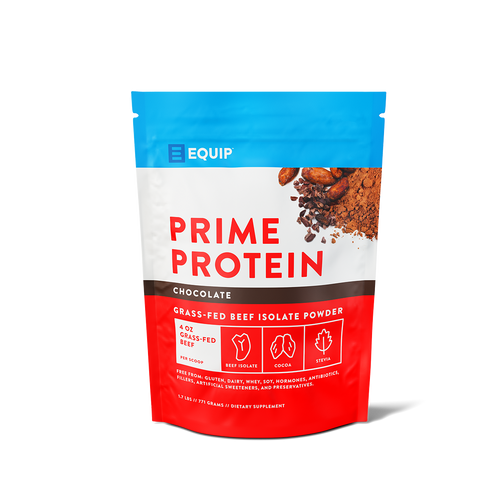Whey is the most popular protein powder on the market! It's generally cost-effective, bioavailable, and mixes easily. It's also available virtually anywhere from convenience stores to grocers and online. That does not tell the whole story though!
Whey is derived from the cheesemaking process. Once the milk passes quality tests, enzymes are added to separate the curd from the liquid whey. The liquid whey is then pasteurized and the protein is concentrated and isolated. Given that it's a dairy product, many people experience digestive discomfort, bloating, and even acne from insulin-like growth factor 1 (IGF-1). In addition, whey can spike blood sugar and is quite slanted in amino acid profile, containing little glycine and proline.
In contrast, our Prime Protein is beef isolate protein, made by turning grass-fed pasture-raised meat and beef bones into a fine powder. It is the nutritional equivalent of consuming 4oz of defatted steak, and it's dairy free! Most people find our beef protein powder far easier to digest, no bloating or gastrointestinal distress. Given it's made from beef, it has a more robust micronutrient profile, packed with collagen and gelatin. It also contains more creatine, iron, and B12.
Several studies suggest that beef protein isolate (like our Prime Protein) may be more advantageous than whey protein:
In one study on 30 college-aged resistance trained men, use of beef protein isolate resulted in a slightly higher increase in lean body mass than whey (5.7% vs 4.7%). No significant differences were observed in strength gains, but the beef protein also resulted in slightly more fat loss than whey (10.8% vs 8.3%).
-
A second study noted that 20 grams of beef protein was better for preserving or increasing thigh muscle mass in 24 master-age (35-60 years old) triathletes during triathlon training compared to whey protein. Additionally, only beef protein significantly improved iron status. Furthermore, there was a numerically greater reduction in fat mass with Beef (-6.7%) vs. whey (-4.1%).
-
A third study compared 20 grams of beef or whey protein in 8 recreationally active males. Increase in fat-free mass was higher with Beef (2.0%) vs. Whey (1.4%) protein. Additionally, beef increased biceps brachialis thickness 11.2% vs. 1.1% with whey. Furthermore, only beef protein increased arm and thigh circumferences. The 1 rep max for squat was also higher with Beef (21.6%) vs. whey (14.6%) and 1 rep max for bench was also higher (15.8% vs. 5.8%, respectively).
-
All sources are included below.
In summary, beef protein isolate has shown the following advantages over whey protein isolate:
-
Easier to digest with limited to no digestive discomfort or bloating
-
Increased muscle hypertrophy and strength
-
Increased fat loss
-
More balanced methionine/glycine ratio (~ 3-times higher in glycine)
-
Non-dairy (for those with dairy allergy/intolerance)
-
Better source of iron and vitamin B12
-
Higher source of creatine
Prime Protein is our clean protein powder. The cleanest beef isolate protein powder on the market. Sourced from grassfed pasture-raised cows and provided in a variety of flavors. Prime goes great in clean coffee or combined with colostrum powder for additional nutrition.
Sources:
-
Sharp, M., Shields, K., Lowery, R., Lane, J., Partl, J., Holmer, C., Minevich, J., Souza, E. D., & Wilson, J. (2015). The effects of beef protein isolate and whey protein isolate supplementation on lean mass and strength in resistance trained individuals - a double blind, placebo controlled study. Journal of the International Society of Sports Nutrition, 12(Suppl 1), P11. https://doi.org/10.1186/1550-2783-12-S1-P11
-
Naclerio, F., Seijo, M., Larumbe-Zabala, E., Ashrafi, N., Christides, T., Karsten, B., & Nielsen, B. V. (2017). Effects of Supplementation with Beef or Whey Protein Versus Carbohydrate in Master Triathletes. Journal of the American College of Nutrition, 36(8), 593–601. doi:10.1080/07315724.2017.1335248
-
Naclerio F, Seijo M, Larumbe-Zabala E, Earnest CP. Carbohydrates Alone or Mixing With Beef or Whey Protein Promote Similar Training Outcomes in Resistance Training Males: A Double-Blind, Randomized Controlled Clinical Trial. Int J Sport Nutr Exerc Metab. 2017 Oct;27(5):408-420. doi: 10.1123/ijsnem.2017-0003. Epub 2017 May 22. PMID: 28530448


